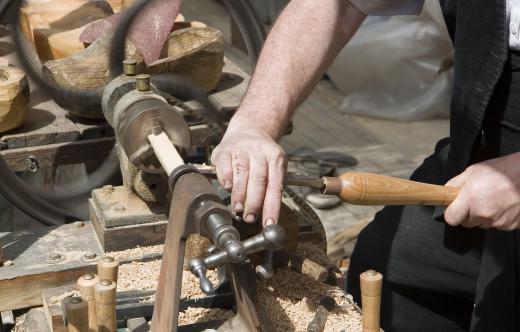A tailstock is a device found on both engine and wood lathes and occasionally on different types of milling machines. Tailstocks run along the longitudinal, or X-axis of the lathe bed. They have the ability to serve a wide variety of purposes on the lathe, but they often are used to turn a piece of metal stock between centers. Doing so not only improves the accuracy of the turning process but also can help to prevent chatter, which occurs when the metal starts to bend while being turned.
The tailstock usually consists of five different components. The first component is the body, which makes up most of the device. The body is attached to an adjustable base below it, which runs along the lathe bed. A feed screw is used to move the tailstock, which is turned by a hand wheel located on the back of the device.

On some lathes, the speed at which the device travels along the bed can be controlled with built-in reduction gears. After the device has been moved to a desirable location, it is then locked into place with a lever. Then, the workpiece is secured to the tailstock spindle, which holds the workpiece in place at its center of rotation.
A tailstock typically is made of a durable, heavy material, such as cast iron, because of their frequent use and importance. While in use, a lathe center is mounted to the inside end of the device, which helps to secure the workpiece as it rotates. This is especially useful for larger lathes, in which the capacity between centers is exceptionally long. This makes it so that longer workpieces, such as rifle barrels, can be secured properly while being machined. Unsecured long pieces of material not only can result in chatter but also can throw off turning accuracy.

Although the tailstock primarily is used for turning between centers, it also can serve other equally important purposes. Tailstocks can be fitted with different types of bits and tools. These make the tailstocks capable of performing drilling, boring and threading tasks.
A tailstock drill consists of a drill bit secured in the same area where the spindle would be. As the workpiece spins, the tailstock remains stationary. It then can be used to bore holes in the workpiece as it moves up and down the lathe bed. For finishing or for larger work, a boring bar can be mounted in the same fashion and used for boring procedures.
For threading the ends of stock, a tailstock die also can be employed. This is similar to what one would find in a tap-and-die set, but these are specially made with set screws to hold them securely in place. Much like the drilling and boring processes, the tailstock remains stationary as the workpiece rotates. During this sort of procedure, however, the workpiece typically rotates at much lower speeds.
